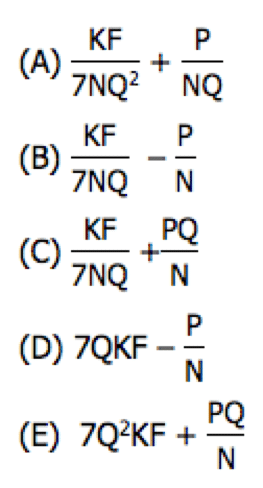
The GMAT is known to be significantly more challenging than the SAT and ACT, the high school exams. However, it is widely considered less challenging than the LSAT or MCAT, the law school and medical school exams, respectively. Of course, it’s always good to remember that test difficulty is a subjective matter. Individual opinions vary regarding which test is, in fact, more or less challenging. This is especially true when comparing the GMAT to the GRE: Students who excel at math and struggle with verbal, tend to find the GMAT easier to navigate. Conversely, students who are verbal dynamos but flounder a bit with quantitative subject matter, tend to find the GRE friendlier than the math-heavy GMAT.
Bottom line: Answering the question, How Hard is the GMAT, depends on a host of individual factors such as your background in math and reading, test-taking skills, and the schools you are targeting.
Table of Contents
- Comparing the GMAT’s Structure to Other Exams
- What Makes GMAT Test Content Hard
- What is a Competitive GMAT Score?
- How Can I Improve my GMAT Score?
Comparing the GMAT’s Structure to Other Graduate Exams
Length
The GMAT, including the optional 10-minute break, is 2 hours and 15 minutes long, significantly shorter than the previous GMAT version. It’s not quite as short as the GRE, which clocks in at just under 2 hours. Yet, it still requires less time than the LSAT, which takes almost 3 hours to complete and is much shorter than the MCAT, which lasts 7 hours! While this shorter GMAT reduces test fatigue, allowing for more focused performance throughout the exam, it’s still important to practice your pacing and build up your stamina.
Number of Questions
The GMAT has a total of 64 questions spread across three sections:
- Quantitative Reasoning: 21 questions
- Verbal Reasoning: 23 questions
- Data Insights: 20 questions
If we compare the number of questions you have to answer on the GMAT to other exams, the only test with fewer questions is the GRE, and there’s only a difference of 10 questions between the two. The other tests, both in the high school and graduate categories, have significantly more questions to slog through.
Time Per Question
The GMAT provides a different pacing challenge compared to other exams. Here’s a breakdown of the average time per question between the GMAT and GRE:
| Exam | Total Questions | Total Time | Time Per Verbal Question | Time per Quant Question |
|---|---|---|---|---|
| GMAT | 64 | 2.25 hours | 1.96 minutes | 2.15 minutes |
| GRE | 54 | 2 hours | 1.50 minutes | 1.75 minutes |
As you can see, the average time allotted per question for both verbal and quant questions on the GRE is noticeably less than the allotted time for GMAT questions. Yes, the total number of questions plays a part; however, that isn’t the whole picture. Rather, the average time allotted per question tells us more. In particular, it gives us an idea of how difficult the test makers think their own questions are. Because GMAT gives you nearly 2 (or more!) minutes per question, we can deduce that the folks who write GMAT questions know that many of their questions are highly complex, requiring advanced analytical thinking and higher-level computational skills.
Additional reading: GMAT Time Management Tips & Strategies
Section Adaptivity
One thing that sets the GMAT apart from other exams is that it’s “question adaptive.” This just means that, within a section, the question you see next is determined by your performance on all the earlier questions you completed. For example, if you’ve answered 4 hard math questions correctly in a row, your next math question is going to be even harder.
The GRE, on the other hand, is section adaptive. The first verbal section is 12 questions of a mix of difficulties. Depending how well you do on that entire section, the 2nd verbal section will either be easier, about the same, or harder. The other graduate exams, the MCAT and LSAT, are not computer adaptive tests (CATs).
If you want to dig deeper into the differences between question adaptivity (GMAT) and section adaptivity (GRE), check out this snippet of the conversation our GMAT expert, Erika, had with representatives from both ETS and GMAC:
More on the GMAT vs the GRE
Why so many mentions of the GRE? Because it’s a direct competitor to the GMAT: the vast majority of business schools accept either GRE or GMAT scores. Read our full comparison of the two exams to see which test is best for you.
What Makes GMAT Test Content Hard
Quantitative Reasoning (QR)
The Quantitative Reasoning section evaluates a candidate’s ability to solve complex problems using basic arithmetic and algebra. While the math concepts themselves may not be advanced, the questions often require sophisticated interpretation and application of mathematical principles in real-world contexts. This section features Problem Solving questions, where candidates must decipher and solve multifaceted word problems. These scenarios often involve strategic decision-making, numerical analysis, and data interpretation, reflecting the challenges faced in business and management roles.
Verbal Reasoning (VR)
Verbal Reasoning on the GMAT assesses a candidate’s ability to comprehend and evaluate written material, analyze arguments, and apply critical thinking skills. This section comprises Reading Comprehension passages and Critical Reasoning questions. Reading Comprehension tasks candidates with understanding and interpreting complex texts from various disciplines, followed by questions that probe deeper into the passage’s details, structure, and implications. The other type, Critical Reasoning, challenges candidates to assess arguments by identifying assumptions, strengths, and weaknesses, requiring them to think analytically and logically. All this takes place while working under tight time constraints.
Data Insights (DI)
Introduced with the launch of the new version of the GMAT, the Data Insights section underscores the growing importance of data literacy in modern business environments. The data is presented in short paragraphs, tables, charts, and graphs, and answer choices occur in a variety of formats. Given the numerous question types, students must be flexible and pivot quickly amongst the best strategies for each DI question type, which include Multi-Source Reasoning, Table Analysis, Graphics Interpretation, Two-Part Analysis, and Data Sufficiency. Like the previous two sections, effective time management is an essential component of mastering the DI section.
Pacing
It can be argued that the time crunch is one of the main factors that makes GMAT content so dang hard! Therefore, establishing and practicing a pacing strategy that works to achieve your GMAT goal is an essential early step. You should know exactly how long you should spend answering each question type, and the questions for which you will likely make an educated guess and quickly move on. Almost no one gets every question right on the GMAT, and that’s not a goal that most test-takers should strive to achieve. Taking well-placed, educated guesses on difficult questions ensures that you’ll have enough time to attempt all the questions and avoid careless errors. Check out more in our GMAT Timing Strategy post.
What is a Competitive GMAT Score?
The GMAT scoring range is now 205-805 (the older exam range was 200-800), with each section (Quantitative, Verbal, and Data Insights) scored from 60 to 90. Within this range, a score above the 50th or 60th percentile is typically necessary for somewhat competitive programs, and scores at or above the 90th percentile are competitive at the most prestigious programs. If you want more detailed information about scores and programs check out this post on Average GMAT Scores: Top 50 MBA Programs.
Knowing what score you need to be competitive at the programs to which you will apply is key. Again, this is an exercise in subjectivity. If you are applying to one of the top programs, you will need a much higher GMAT score to be competitive. If you are applying to programs that aren’t in the upper echelon, then you will not necessarily need a 90+ percentile score to be competitive. To figure out what score you need, you must do the research. Look up the schools to which you want to apply and find out the average GMAT scores.
How Can I Improve My GMAT Score?
Take A Diagnostic Test
First and foremost, taking a free GMAT practice test can help you gauge your starting point and identify your strengths and weaknesses. It will also give you a sense of the gap between your current score and the score you need for the programs you’re targeting.
Become a GMAT Expert
Know everything there is to know about the GMAT by absorbing the information in Magoosh’s Complete GMAT Guide. You’ll learn how the GMAT is designed and scored, what skills it tests, and how to study for each test section.
Follow the Right Study Schedule
Next, you need to find the right study schedule. There is a lot of ground to cover in preparing for the exam. The most successful test-takers organize their prep according to the amount of time they have to prepare and the content areas that pose the greatest challenges to mastery. For example, it typically takes a lot longer to see improvement in VR versus QR. If you know you are weaker in verbal concepts, you’ll likely want to follow a schedule that is at least 6 months in length.
Use the Best Prep Materials
In terms of a prep course that will guide you through everything you will need to be prepared for on exam day, check out Magoosh’s Premium Subscription, which includes a free one-week trial period.
For practice material, go with the questions written by the folks who write the GMAT: GMAC’s GMAT Official Guide (OG)–The newest edition of the e-book and online question bank is here: OG 2023-2024. If you are going to buy a new guide, get that one.
Track Your Progress
We cannot emphasize enough the importance of keeping a record of your progress. Do so by using an error Log. If you aren’t sure how to set up your error log, check out Magoosh’s free template.
Final Thoughts
Only you can truly answer “How hard is the GMAT?” However, whether the path forward seems daunting or manageable, Magoosh is here to help! Our GMAT Premium Plan has comprehensive lessons and practice questions to help you master the exam and achieve your target score.
Happy Studying!





